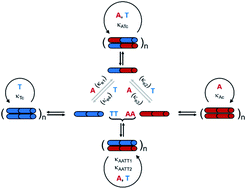Collective adaptability in a replication network of minimal nucleobase sequences†
Abstract
A major challenge for understanding the origins of life is to explore how replication networks can engage in an evolutionary process. Herein, we shed light on this problem by implementing a network constituted by two different types of extremely simple biological components: the amino acid cysteine and the canonical nucleobases adenine and thymine, connected through amide bonds to the cysteine amino group and oxidation of its thiol into three possible disulfides. Supramolecular and kinetic analyses revealed that both self- and mutual interactions between such dinucleobase compounds drive their assembly and replication pathways. Those pathways involving sequence complementarity led to enhanced replication rates, suggesting a potential bias for selection. The interplay of synergistic dynamics and competition between replicators was then simulated, under conditions that are not easily accessible with experiments, in an open reactor parametrized and constrained with the unprecedentedly complete experimental kinetic data obtained for our replicative network. Interestingly, the simulations show bistability, as a selective amplification of different species depending on the initial mixture composition. Overall, this network configuration can favor a collective adaptability to changes in the availability of feedstock molecules, with disulfide exchange reactions serving as 'wires' that connect the different individual auto- and cross-catalytic pathways.

- This article is part of the themed collection: 2022 Chemical Science HOT Article Collection


 Please wait while we load your content...
Please wait while we load your content...